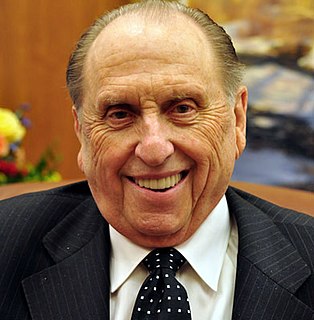
Thomas Spencer Monson was an American religious leader, author, and the 16th President of The Church of Jesus Christ of Latter-day Saints. As president, he was considered by adherents of the religion to be a prophet, seer, and revelator. Monson's early career was as a manager at the Deseret News, a Utah newspaper owned by the LDS Church. He spent most of his life engaged in various church leadership positions and public service.
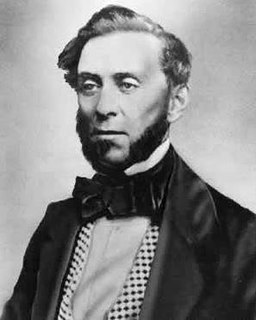
Samuel Brannan was an American settler, businessman, journalist, and prominent Mormon who founded the California Star, the first newspaper in San Francisco, California. He is considered the first to publicize the California Gold Rush and was its first millionaire. He used the profits from his stores to buy large tracts of real estate. He helped form the first vigilance committee in San Francisco and was disfellowshiped from The Church of Jesus Christ of Latter-day Saints because of his actions within the vigilance committee. Brannan's wife divorced him and he was forced to liquidate much of his real estate to pay her one-half of their assets. He died poor and in relative obscurity.
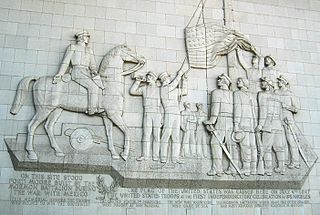
The Mormon Battalion was the only religious unit in United States military history in federal service, having been recruited solely from one religious body and having a religious title as the unit designation. The volunteers served from July 1846 – July 1847 during the Mexican–American War of 1846–1848. The battalion was a volunteer unit of between 534 and 559 Latter-day Saint men, led by Mormon company officers commanded by regular U.S. Army officers. During its service, the battalion made a grueling march of nearly 2,100 miles from Council Bluffs, Iowa, to San Diego, California.

The Seagull Monument is a small monument situated immediately in front of the Salt Lake Assembly Hall on Temple Square, in Salt Lake City, Utah. The Monument commemorates what some members of The Church of Jesus Christ of Latter-day Saints call the miracle of the gulls.

Mahonri Mackintosh Young was an American social-realist sculptor and artist. During his lengthy career, he created more than 320 sculptures, 590 oil paintings, 5,500 watercolors, 2,600 prints, and thousands of drawings. However, he is primarily recognized for his sculpture. His work includes landscapes, portraits, busts, life-size sculptures, monuments, and engravings. Regardless of his medium of choice, his work is characterized by spontaneity; he often preferred to prepare his work with quick sketches on the scene. He felt this made his work more natural as compared to using a model in the studio. He was fairly commercially successful during his life, though he did not find success until his mid-30s. Large commissions for sculptures from The Church of Jesus Christ of Latter-day Saints were particularly lucrative for him.
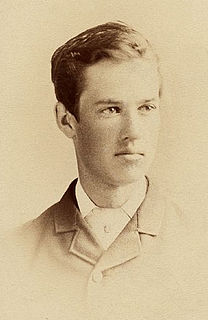
Cyrus Edwin Dallin was an American sculptor best known for his depictions of Native Americans. He created more than 260 works, including the equestrian statue of Paul Revere in Boston, Massachusetts; the Angel Moroni atop Salt Lake Temple in Salt Lake City, Utah; and his most famous work, Appeal to the Great Spirit, at the Museum of Fine Arts, Boston. He was also an Olympic archer.
Levi Savage Jr. is a prominent figure in the history of The Church of Jesus Christ of Latter-day Saints. He was one of the earliest LDS Church missionaries to Asia, and was one of the leaders of the Mormon pioneer Willie Handcart Company.

The This is the Place Monument is a historical monument at the This is the Place Heritage Park, located on the east side of Salt Lake City, Utah, at the mouth of Emigration Canyon. It is named in honor of Brigham Young's famous statement in 1847 that the Latter-day Saint pioneers should settle in the Salt Lake Valley. Mahonri M. Young, a grandson of Brigham Young, sculpted the monument between 1939 and 1947 at Weir Farm in Connecticut. Young was awarded $50,000 to build the monument in 1939 and he was assisted by Spero Anargyros. It stands as a monument to the Mormon pioneers as well as the explorers and settlers of the American West. It was dedicated by LDS Church President George Albert Smith on 24 July 1947, the hundredth anniversary of the pioneers entering the Salt Lake Valley. It replaced a much smaller monument located nearby.
Edward Bunker was a Mormon pioneer and community founder of Bunkerville, Nevada.

Avard Tennyson Fairbanks was a 20th-century American sculptor. Over his eighty-year career, he sculpted over 100 public monuments and hundreds of artworks. Fairbanks is known for his religious-themed commissions for The Church of Jesus Christ of Latter-day Saints including the Three Witnesses, Tragedy of Winter Quarters, and several Angel Moroni sculptures on LDS temple spires. Additionally, Fairbanks sculpted over a dozen Abraham Lincoln-themed sculptures and busts among which the most well-known reside in the U.S. Supreme Court Building and Ford's Theatre Museum.
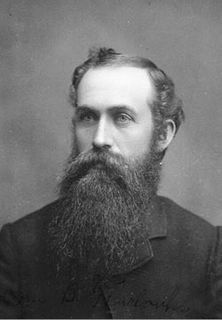
John Boylston Fairbanks was an American landscape painter. In 1890, he was one of a group of artists who studied in Paris under the sponsorship of The Church of Jesus Christ of Latter-day Saints, in preparation for painting murals at the nearly completed Salt Lake Temple. He painted murals in the Salt Lake Temple and the Mesa Arizona Temple that still exist today. Fairbanks was the official photographer for the South American expeditions of Benjamin Cluff. Fairbanks was the first artist to live and paint in Zion National Park. He was an early art instructor at Brigham Young Academy and was one of the founding members of the Utah Art Institute. Fairbanks was the father of sculptor Avard Fairbanks.

As of December 31, 2019, The Church of Jesus Christ of Latter-day Saints reported 756,507 members in 153 stakes, 1,229 congregations, 228 Family History Centers, 15 missions, and seven temples in California.

Edward J. Fraughton is an American artist, sculptor, and inventor. He is primarily known for his epic monumental works and individual collector editions that often relate to the history of the American West. Fraughton's stylistic goals follow the American Neo-classic/Beaux-Arts, impressionistic realism traditions of J. Q. A. Ward, Henry Merwin Shrady, James Earle Fraser, Hermon Atkins MacNeil, Daniel Chester French, Augustus Saint Gaudens, Cyrus Dallin, Gutzon and Solon Borglum, and American animaliers Arthur Putnam, Edward Kemeys, Phimister Proctor. A literal sculptor with an academic background in design and human anatomy, Fraughton's versatility covers a broad spectrum of human and animal subjects.
Kent Farnsworth Richards has been a general authority of The Church of Jesus Christ of Latter-day Saints since 2009.

Torleif Soviren Knaphus was a Norwegian-born artist and sculptor in Utah, primarily known for sculptures for and about The Church of Jesus Christ of Latter-day Saints.

For the 1969 monument in San Diego, California, see Mormon Battalion Monument.
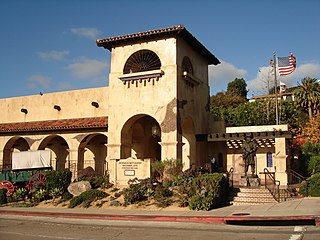
The Mormon Battalion Historic Site is a historic site in Old Town, San Diego, California, in honor of the members of The Church of Jesus Christ of Latter-day Saints who served in the United States Army's Mormon Battalion during the Mexican–American War of 1846–1848. The battalion was stationed in Old Town in 1847, and they built wells and a courthouse on the site. In the 1960s, the LDS Church opened a visitor center to commemorate their historical ties to San Diego. A new visitor center was dedicated on January 30, 2010.

The Mormon Trail Center at Historic Winter Quarters is a museum and visitors' center of The Church of Jesus Christ of Latter-day Saints located in the Florence neighborhood of Omaha, Nebraska, United States. The museum interprets the story of the Mormon Trail along with the history of a temporary Mormon settlement known as Winter Quarters, which was located in the Florence area between 1846–1848.















